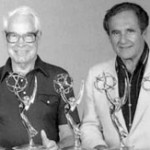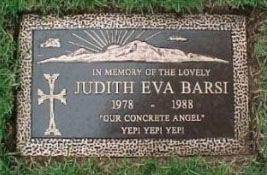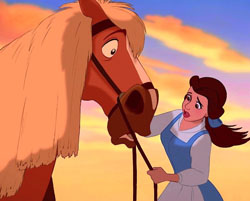
Early in Tezuka’s career he illustrated Disney books and adapted comics of several Disney movies – including BAMBI (published in Japan in 1951)
“I admire Walt Disney, I am charmed by Walt Disney, and I decided my career inspired by Walt Disney. And I met him in New York, or, I should say, I just walked past him. On the opening day of New York World’s Fair, was lucky enough to get a chance to talk to him. I came across him leaving the stage just after delivering the speech. I got nervous but somehow introduced myself to him.
‘I am a head of a Japanese animation studio.’
‘Nice to have you here.’
‘I am the one who made Astro Boy.’
‘Really? I know Astro Boy. I saw the work in Los Angeles. It’s a great work.”
‘Thank you very much. My staff would be honored. Well, may I have your comment about the work?’
‘It’s a very interesting Sci-Fi story. Future children are looking toward the space. So I, myself, think about making Sci Fi, too. If you have time, visit me in Burbank.’
 The Hanna-Barbera Partnership. In the Los Angeles Times August 29th, 1988, animation producer Joe Barbera said, “We lean toward different areas of the business, so we each get to do what we like. I work on creating the ideas for the projects, and trying to sell those ideas in the various markets. Bill oversees the actual production in studios all over the world, which I would hate doing. When Bill’s out of town, I turn the light out behind his name on the studio sign, but he does the same thing to me when I’m gone so we stay even. I have to answer a question that has been asked a lot lately. How can two people work together for 50 years and not fight? We did fight the very first week and we haven’t spoken since.”
The Hanna-Barbera Partnership. In the Los Angeles Times August 29th, 1988, animation producer Joe Barbera said, “We lean toward different areas of the business, so we each get to do what we like. I work on creating the ideas for the projects, and trying to sell those ideas in the various markets. Bill oversees the actual production in studios all over the world, which I would hate doing. When Bill’s out of town, I turn the light out behind his name on the studio sign, but he does the same thing to me when I’m gone so we stay even. I have to answer a question that has been asked a lot lately. How can two people work together for 50 years and not fight? We did fight the very first week and we haven’t spoken since.”
 Judith Barsi. A visibly shaken Don Bluth had to break the news to his studio staff in July 1988 of the still-in-production All Dogs Go to Heaven (1989) that ten year old Judith Barsi who had done the voice for the orphan character Anne-Marie who could talk to animals had been killed by her father. He shot the little girl in her head while she was sleeping and then shot her mother, set their bodies on fire two days later in their San Fernando Valley home and then shot himself in the garage. After the announcement, Bluth left the studio for the rest of the day.
Judith Barsi. A visibly shaken Don Bluth had to break the news to his studio staff in July 1988 of the still-in-production All Dogs Go to Heaven (1989) that ten year old Judith Barsi who had done the voice for the orphan character Anne-Marie who could talk to animals had been killed by her father. He shot the little girl in her head while she was sleeping and then shot her mother, set their bodies on fire two days later in their San Fernando Valley home and then shot himself in the garage. After the announcement, Bluth left the studio for the rest of the day.
“Her father was crazy. They were having marital problems, and he used a lot of verbal abuse and had been threatening them for a long time,” said Ruth Hansen who was Judith’s agent. The end credits song “Love Survives” was dedicated in her memory. Judith also voiced the character of Ducky in The Land Before Time (1988). Bluth had intended to use her extensively in publicity for the film and in future productions.
Working at UPA. From the book Musician: A Hollywood Journal (Lyle Stuart 1987) by composer Lyn Murray comes these insights of his time working at UPA:
“(July 5, 1956 diary entry) Working at UPA is largely a pain in the ass. An atmosphere has somehow been created there that makes everyone feel completely unimportant. All the brilliant artists complain that they are paid almost nothing. It is nice working with Jules Engel, Fred Crippen and other fine talents but it is Mel Leven who cheers me up no end. I have just done a score for a delightful picture called “The Unenchanted Princess” in which Edward Everett Horton does the narration in his usual enchanting style. Andre Previn plays the harpsichord.
“I had an unlucky session for “Brother John”, a little film about a French town. We used ‘Sur Le Pon D’Avignon’ and ‘Frere Jacques’. The film was directed by a nice bright fellow named Bill Scott who does a lot of bitching about how the properties we do have to conform to Bobe Cannon’s leanings towards Christian Science and his subservience to the PTA. Scott systematically took out all the poetry and charm.”
By the way, Murray also worked with John Hubley on the ill-fated cartoon feature of Finian’s Rainbow and talks about the recording sessions with Frank Sinatra, Ella Fitzgerald and Louis Armstrong.
Behind the Horse. In the 1992 Equus magazine article by Tracy Gantz, animator Russ Edmonds talked about his input on designing the horse Philippe for Beauty and the Beast (1991). His assistant was Brian Clift who cleaned up some of the Edmonds’ original drawings.

“I know that he’s a farm horse who retired early. He doesn’t pull a plow anymore, but he does pull a wagon. And the best thing in his life would be to stand, and to stand near Belle would be better.
“We decided to make Philippe very bulky, very clunky and his knees were big. He had big hefty knees and big hefty feet. He couldn’t look too goofy because the people that ride him aren’t goofy. He couldn’t stand up on his back legs and sing a song. And since Philippe was very realistic, it made the other characters in the house seem outlandish.
“I created Philippe’s tack. The story required both riding equipment and harness to pull a cart. I discovered a tack arrangement like that and made some adjustments. Maurice had to be close to Philippe’s head so that they could relate to each other. This was all figured out in the story so that they could be close together but no one figured it out physically.
“The cart holds an invention of Maurice’s so we decided that the invention should completely fill the cart. That way, Maurice must ride the horse because there is no room for him in the cart. We covered the invention with a tarp which seems a sensible thing to do but it also means that the animators did not have to repeatedly draw the intricate invention for each frame.
“Missing from Philippe’s tack is no bit and no stirrups. I didn’t want the bit to interfere with his mouth. He doesn’t talk, but he does have a lot of expressions with his mouth. Another animator would draw the rider so I wouldn’t know where the rider’s feet would be for the stirrups. In addition, when Belle rides Philippe she wears a dress that would have covered them anyway.”


 Jim Korkis is an internationally respected animation historian who in recent years has devoted his attention to the many worlds of Disney. He was a columnist for a variety of animation magazines. With his former writing partner, John Cawley, he authored several animation related books including The Encyclopedia of Cartoon Superstars, How to Create Animation, Cartoon Confidential and Get Animated’s Animation Art Buyer’s Guide. He taught animation classes at the Disney Institute in Florida as well as instructing classes on acting and animation history for Disney Feature Animation: Florida.
Jim Korkis is an internationally respected animation historian who in recent years has devoted his attention to the many worlds of Disney. He was a columnist for a variety of animation magazines. With his former writing partner, John Cawley, he authored several animation related books including The Encyclopedia of Cartoon Superstars, How to Create Animation, Cartoon Confidential and Get Animated’s Animation Art Buyer’s Guide. He taught animation classes at the Disney Institute in Florida as well as instructing classes on acting and animation history for Disney Feature Animation: Florida.




















































I would love to see a animé version of Bambi either as a feature film or a tv series.
Lyn Murray’s anecdote on Bobe Canon vs. Bill Scott is fascinating in terms of what it shows about the vision of the UPA studio in the post-Hubley era vs. the vision Jay Ward studio.
The UPA studio was filled with artistic innovations placed in stories designed to satisfy the PTA crowd, such as the Gerald McBoing Boing Show or the Ham and Hattie vignettes. But for the most part they weren’t funny and if they had re-watchability, it was for the visuals not for the entertainment value of the stories.
“The Unenchanted Princess” is obviously the precursor for the Ward studio’s “Fractured Fairy Tales”, but you can see the difference between Canon’s vision here and what the latter cartoons ended up like under Bill Scott’s guiding hand. He may have taken out ‘all the poetry and charm’ but what he put in was far more entertaining and re-watchable to most of the public over the past 58 years.
It was pretty obvious that Don Bluth saw something special in Judith. No wonder he was heartbroken about her death. I especially feel sorry for poor Judith and her mother. They were tragically taken all too soon. Her role as Ducky has always touched me ever since I first saw the original The Land Before Time.
In 1944, The Lyn Murray Singers recorded a 78 RPM album of songs from Snow White with the Disney cover art. It was reissued on 45 rpm records and as a 10-inch LP. Here are two selections that ended up on some generic children’s collection:
https://www.youtube.com/watch?v=j8u9yrGoTyE